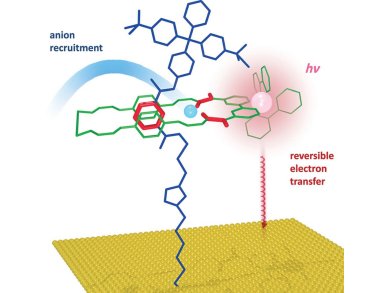Mechanically interlocked molecular architectures are of interest for nanotechnological applications. Rotaxanes and catenanes are of particular interest as selective host systems. In these systems, the topologically unique interlocked 3D cavities of rotaxanes and catenanes can be exploited to selectively recognize specific guest species, such as anions. However, to sense and monitor anion binding, it is desirable to integrate a redox- or photoactive reporter group near the interlocked anion-binding site and to tether the sensor to a surface to aid device integration.
Jason Davis, Paul Beer, and colleagues, University of Oxford, UK, have incorporated an osmium(II) bipyridyl reporter group into [2]rotaxanes. The electrochemically and optically active Os bipyridyl macrocyclic component was mechanically bonded with the cationic pyridinium axles of the rotaxane. The rotaxanes were then surface assembled on to gold electrodes through anion templation under copper(I)-catalyzed Huisgen cycloaddition conditions to form rotaxane molecular films. Upon removal of the templating anion, the films could be used to selectively bind and report on the presence of chloride ions in solution by monitoring the optical and electronic output from the Os bipyridine reporter moiety.
- Anion Sensing by Solution- and Surface-Assembled Osmium(II) Bipyridyl Rotaxanes,
Joshua Lehr, Thomas Lang, Octavia A. Blackburn, Timothy A. Barendt, Stephen Faulkner, Jason J. Davis, Paul D. Beer,
Chem. Eur. J. 2013.
DOI: 10.1002/chem.201302886




